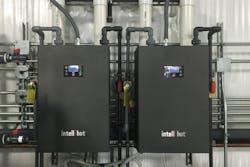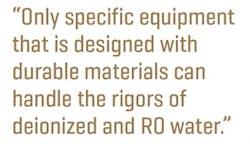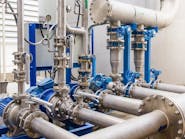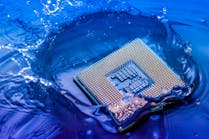Next-generation deionized tankless water heaters
Operators in industrial environments demand rugged yet functional equipment to maintain, heat and treat water and wastewater in their processes. This is true for all systems in the facility, whether HVAC equipment, structural materials, or water heaters and boilers. No matter the perception, non-commercial-grade equipment will not survive in these harsh and demanding environments. Many industrial applications use deionized water, whether for electronics manufacturing, as a dissolution of drugs in medicine, or as the main ingredient in shampoos and cosmetics.
Deionized water
As the name implies, deionized water is water with all the ions removed. Ions are electrically charged atoms or molecules found in water that have either a positive or negative charge.
Cations are the ions that have a positive charge, and anions are the ions with a negative charge. The ratio of these ions in the water can affect whether the water or solution is acidic or basic. Many industrial processes need to create deionized water to rid it of these ions, especially processes that use this water as a rinse or ingredient in a more complex chemical system. The ions are labeled as impurities and need to be removed from the water for the process to function as intended.
Deionization can reduce the amounts of these ions to very low levels through the ion exchange process. Positively charged cations are removed by cation exchange resin. It replaces sodium, calcium, magnesium and other cations with hydrogen ions (H+). This exchange produces acids, which must be removed or neutralized by anion exchange resin. Two general types of anion resin are used for deionization: weak base resin and strong base resin.
Weak base resin adsorbs strong acids, while strong base resin exchanges chloride, sulfate and alkaline anions for hydroxide ions (OH-). The hydrogen ions from the cation exchange process combine with the hydroxide ions from the anion exchange process to form water (HOH or H2O). At the end of the process, this water is free from impurities and many dissolved solids, also known as total dissolved solids, that are present in standard tap water.
Assuming a lack of impurities in water indicates that deionized water presents no issues in delivery or heating is a common misunderstanding. However, the opposite is actually true. This type of water tends to be more severe in regards to the make-up water’s reaction to materials (such as piping, valves and heaters) because of the process of deionization. The lack of certain ions in the deionized water can make the water extremely corrosive to many metals or materials.
The reverse osmosis (RO) process is similar to the deionization process because it removes contaminants from water. However, RO removes a majority of contaminants from water by pushing the water under pressure through a semipermeable membrane. RO is capable of removing up to 99 percent of the dissolved salts (ions), particles, colloids, organics, bacteria and pyrogens from water. Similar to deionized water, RO water is highly reactive and can cause similar problems for the equipment that heats and transports the water.
Only specific equipment that is designed with durable materials can handle the rigors of deionized and RO water. A gas-fired, deionized, on-demand water heater with capacities up to 251,000 British thermal units per hour (BTU/hr) can be installed in small spaces. This tankless water heater type is built to deliver efficient, consistent performance in diverse applications like industrial finishing and cleaning, electronic parts fabrications, food processing, water purification, aerospace, cosmetics, pharmaceuticals, and glass industries. It also can be installed in processes and applications that use water treated by RO.
Case study
Culligan is an international water treatment company specializing in water filtration systems and bottled water for residential and office applications. The company currently has more than 600 dealers in the U.S. and Canada and sells its products in more than 90 countries. Since it was founded in 1936, the brand has become well-known because of its slogan, “Call your Culligan man.”
Culligan built a new, 25,000-square-foot water treatment plant in Indianapolis. During construction planning in 2015, the managers needed durable equipment that could keep up with the plant’s high demand for deionized water for use in its water bottle cleaning process. The process needed an efficient way to heat deionized water at an industrial level that also had a small footprint for the installed equipment. With the demands and corrosion problems deionized water can present, this was not an easy decision. Many water heaters use heat exchangers that can fail and that are not engineered to withstand the demands of industrial applications.
The challenge
The daily obligations for this Culligan facility included the heating of deionized water for heavy-duty cleaning demands while maintaining a small footprint to save valuable floor space. The property was looking for a small solution with a large output.
The solution
Two deionized water heaters were installed and cascaded together to instantaneously heat deionized water for the cleaning process. The ¾-inch, stainless-steel heat exchangers met the plant’s daily demand for deionized hot water. The wall-hung units were also mounted within a small footprint in the plant, allowing for elevated installation and much needed extra square footage. Accommodating a storage tank would have cost the facility more per square foot.
When asked about the decision to buy a deionized, tankless water heating system, Jack Wintrow, commercial sales manager for Culligan in Indianapolis, said, “We were looking for an all stainless-steel water heater to heat deionized water for our drinking water bottling cleaning process. After reviewing … literature, we learned about on-demand water heating technology and the small footprint it provides. We purchased two units and installed them ourselves.”
The deionized units withstand consistent, high-temperature demands without catastrophic failures. Each model uses commercial-grade heat exchangers. The 316L, low-mass coils enable rapid responses to varying flow rates and are resistant to thermal shock.
The floating coils are resilient against harsh cycles and, with no welds on the water side, eliminate stress corrosion cracking issues. The condensate and flue gasses flow in the same direction to wash away residues and prevent corrosion, creating a heat exchanger that is self-descaling.
The units also include masterless cascade controls that eliminate the risk of single-point failures. With this design, up to 10 units can be cascaded together for a combined capacity of more than 2.5 million BTU/hr. Every unit has enough internal logic to operate independently, allowing it to function smoothly if a heater needs to be checked or serviced. This technology allows the Culligan facility to operate without interruption and eliminates the need for back-up heaters.
The sustainable equipment also provides the plant with 96 percent real-world efficiency, which offers measurable operational savings. Because of their on-demand technology, the units have the capacity to meet peak draws while alleviating excessive cycling by only heating water when needed. Their condensing nature presents precise temperature control and greatly reduces losses while improving efficiency. Without the purging, standby and heat exchanger losses that are typically seen in a system that uses a tank, more money and energy go toward heating the deionized water on which Culligan depends for its cleaning process.
Further tankless improvements
Next-generation deionized tankless water heaters, which include additional features such as Wi-Fi and 3G/4G connectivity, are now available. Each unit can be connected to a wireless router or through a proprietary internet hub. This enables remote access and monitoring of all the equipment. This new technology uses intuitive, touchscreen interfaces and allows for accessing daily, weekly and monthly usage data, troubleshooting info and monitoring the life of parts.
Most new equipment can be monitored using mobile apps. They allow personnel to check water inlet/outlet temperatures, flow rates, flue gas temperatures and combustion rates from mobile devices. While the deionization of water may seem like a complicated concept, heating it should be easy. With tankless units, a facility can continue to focus on delivering high-quality products to and not water-heating challenges.
Jason Smith is an applications engineer at Intellihot Green Technologies Inc. He became a licensed Professional Engineer in 2006 and has been involved in the design process of most types of building mechanical systems for more than 15 years, including plumbing and hydronic heating systems, both from the manufacturer and the specifying engineering perspectives.
Valerie Daves leads business development efforts at Intellihot Green Technologies Inc. She helps customers save energy and space, reduce operating and capital expenses and increase reliability with the company’s tankless, on-demand water heating technology. For more information on the equipment detailed in this article, visit intellihot.com.



